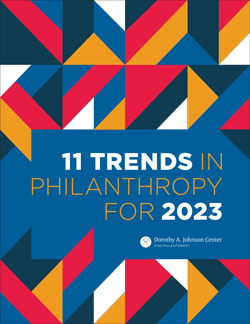The Rise of Collaborative Funding


 This article was first published in our 11 Trends in Philanthropy for 2023 report. Explore all 11 trends in the report.
This article was first published in our 11 Trends in Philanthropy for 2023 report. Explore all 11 trends in the report.
Want the latest trends, research, and more delivered right to your inbox? Subscribe to the Johnson Center email newsletter.
Throughout the history of the United States, people have leveraged their social capital and financial resources to benefit their communities. Whether it was the mutual aid societies of the late 1700s (Duran, 2001), the rise of United Ways in the industrial age, or giving circles of the 21st century, collaborative giving isn’t new in the sector. What is new, however, is the rapid growth of funder collaboratives among institutional funders and the amount of funding they’re moving into the sector.
Some attribute this growth “in part to wealth accumulation over the past decade coupled with increasing interest in new ways of giving” (Powell et al., 2021, p. 4). This movement from traditional methods of resource development and distribution to more collaborative efforts can bring increased efficiency and effectiveness. Releasing the Potential of Philanthropic Collaborations, published by the Bridgespan Group in 2021, demonstrated the increased pace of establishing new collaboratives, noting that over half of those surveyed launched collaboratives after 2015. The greatest acceleration happened in 2020 when 16 survey respondents established collaboratives, “the highest number of organizations established in a single year” (Powell et al., 2021, p. 4).
Collaborative funding is a way “to align … philanthropic giving based on shared long-term goals, geographic areas of interest, beneficiary populations, or some other commonality” (Milken Institute, 2020, para. 2). The long-term focus of collaborative funding often centers on creating systemic change by building resources and movements. It’s a recognition that “participants in a philanthropic collaborative can magnify their capacity to address large-scale social, economic, and environmental challenges and better contribute to change” (Rockefeller Philanthropy Advisors, 2021, para. 1).
An example: Bringing together resources, expertise, and willpower is what The Audacious Project seeks to do through its collaborative. Housed at TED, The Audacious Project builds partnerships with over three dozen individual donors and institutional funders “to match bold ideas with catalytic resources” (2022, para. 3) — including some of the biggest names in philanthropy, such as Mackenzie Scott, the Bill and Melinda Gates Foundation, and the Skoll Foundation. Launching projects in a cohort style, The Audacious Project has invested in everything from climate change to immigration justice. In 2021 alone, the collaborative moved $920 million into the social sector across the globe.
“The long-term focus of collaborative funding often centers on creating systemic change by building resources and movements.”
Big investments are what drive Blue Meridian Partners, a “collaborative philanthropic community whose partners share the costs, risks, and successes of performance-based investing …. to improve the lives of young people and families living in poverty in America” (2022, paras. 1-2). Investing no less than $100 million in each nationwide initiative, Blue Meridian Partners — which includes Charles and Lynn Schusterman Family Philanthropies, Aviv Foundation, the Duke Endowment, as well as many of The Audacious Projects’ supporters and others — is providing capital to scale projects with a proven track record.
Not all collaboratives are designed to move such big ideas, some focus on creating change in a specific area. Birthed in 2020, the Michigan Justice Fund is “dedicated to advancing justice reform and the economic mobility of individuals with criminal convictions in Michigan” (2022a, para. 4). Although housed at the Community Foundation for Southeast Michigan, this young collaborative includes 14 funders from across the state and the country. Grants made in 2021 ranged from over $300,000 to research prosecutorial decision-making, down to $50,000 for a doula initiative to support women giving birth while incarcerated (Michigan Justice Fund, 2022b).
The scale of gifts from collaboratives ranges significantly, much like traditional philanthropy, yet there are key differences in collaborative funding. The Bridgespan research (2021) identified some key areas that distinguish collaborative funding from traditional philanthropic giving, including an increased focus on funding systemic issues and racial justice, as well as more diverse leadership with collaboratives. The researchers noted that “nearly half of the funds reported being led by people of color” (Powell et al., 2021, p. 7). In comparison, people of color comprised only 10% of CEOs and leaders across U.S. foundations (Philanthropy News Digest, 2020).
With increased leadership from communities of color, it would make sense that collaborative funders place a higher priority on racial justice. While the Bridgespan study (2021) did not identify specific dollar amounts given to racial justice, respondents did identify the category as the top funding priority, and “almost all of these funds referenced racial inequities, centered Black, Indigenous, and people-of-color (BIPOC) populations, and/or challenged engrained power hierarchies when describing their change objectives” (Powell et al., p. 6).
This focus on challenging traditional power dynamics and moving money to BIPOC communities could significantly change the landscape and impact of nonprofit organizations. It also represents a dramatic shift from historically low funding for racial justice which “has consistently been low — only 10 percent to 20 percent of the scale of the larger racial equity set, and barely 1 percent of all funding” (Philanthropic Initiative for Racial Equity, 2021, p. 8).
The Black Equity Collective is one example of the intentionality of centering philanthropic leaders of color to impact “Black-led and Black-empowering social justice organizations in Southern California” (n.d.a, para. 2). The only philanthropic network in the state of California “solely dedicated to Black issues, to empowering Black voice, and investing in Black leadership and Black organizations” (n.d.b, para. 1), the Collective seeks an investment of $60 million by 2030 (n.d.a).
With all the money that collaboratives are moving into the sector, there are opportunities to create real change and potentially solve complex social issues like food insecurity, racial inequity, and climate change. Yet, as noted in The Stanford PACS Guide to Effective Philanthropy (2021), “the concentration of funds and decision-making authority may have negative consequences as well by enshrining parochial strategies and cozy relationships with particular grantees” (p. 202).
With years of handwringing over the power dynamics in philanthropy, Fozia Irfan (2022) reminds us that to truly shift power requires “redefining expertise, risk, and impact. It would centre the communities we serve, giving them the power to be involved in decision-making, removing barriers to access, and providing a culture which is supportive. It may mean redefining what issues are important — as funders we value change as an indicator of success” (para. 9).
For the growing collaboratives, redefinition is often at the heart of the work. For Big Bang Philanthropy, “a group of like-minded funders working together to find and fund organizations with the best solutions to the toughest problems of poverty” (n.d., para. 1), that means co-funding projects, minimizing paperwork in the grantmaking process, and encouraging their collaborative partners to provide unrestricted funds in all of their giving.
As collaborative funding continues to grow, the Bridgespan Group encourages us to imagine the possibilities: “If U.S. billionaires gave an additional one-half of 1 percent of their wealth to collaboratives, that would amount to roughly $22 billion annually” (Powell et al., 2021, p. 14) flowing to nonprofit organizations across the globe. Imagine the impact.


The Audacious Project. (2022). About. https://www.audaciousproject.org/about
Big Bang Philanthropy. (n.d.) Joining forces against poverty. https://www.bigbangphilanthropy.org/
Black Equity Collective. (n.d.a). About us. https://www.blackequitycollective.org/about-us)
Black Equity Collective. (n.d.b) Why we do it. https://www.blackequitycollective.org/why-we-do-it
Blue Meridan Partners. (2022). Engage with us. https://www.bluemeridian.org/our-partners/engage-with-us/
Duran, L. (2001). Caring for each other: Philanthropy in Communities of Color. Grassroots Fundraising Journal, 20. https://coco-net.org/wp-content/uploads/2012/08/20_5_PhilCommOfColor.pdf
Irfan, F. (2022, July 5). What will it take to shift power in philanthropy? Alliance. https://www.alliancemagazine.org/blog/what-will-it-take-to-shift-power-in-philanthropy/
Michigan Justice Fund. (2022a). About the Michigan Justice Fund. https://cfsem.org/initiative/michigan-justice-fund/about/
Michigan Justice Fund. (2022b). The impact of the Michigan Justice Fund. https://cfsem.org/initiative/michigan-justice-fund/impact-michigan-justice-fund
Milken Institute. (2020). Philanthropist’s field guide: Funder collaboratives: Amplify impact and learning. https://milkeninstitute.org/article/funder-collaboratives-amplify-impact-and-learning
Philanthropic Initiative for Racial Equity. (2021). Executive summary: Mismatched. https://racialequity.org/wp-content/uploads/2021/09/0910_PRE_Mismatched_PR_execsummary02-1.pdf
Philanthropy News Digest. (2020, October 15). Diversity of foundation staff, leadership lags, study finds. https://philanthropynewsdigest.org/news/diversity-of-foundation-staff-leadership-lags-study-finds
Powell, A., Morfit, S., & John, M. (2021, December). Releasing the potential of philanthropic collaborations. https://www.bridgespan.org/insights/library/philanthropy/philanthropic-collaborations
Stanford PACS Center on Philanthropy and Civil Society. (2021). The Stanford PACS Guide to Effective Philanthropy. https://pacscenter.stanford.edu/wp-content/uploads/2021/10/Guide_FINAL_8.5×11.pdf